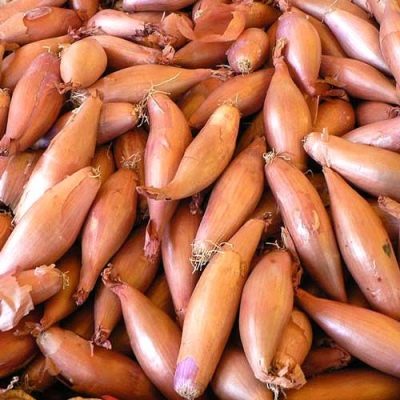
- Ripening terms: early
- Bulb weight, g: 45-50
- The form: elongated
- Dry scales: brown-pink
- Density: dense
- Taste: spicy
- Appointment: salad, for fresh consumption, for canning, for herbs
- Keeping quality: good
- Sevka planting scheme: 15 x 20 cm
- Growing features: grown from seeds and planting small bulbs
Housewives, who are especially fond of cooking, note the exquisite and delicate taste of shallots Delicatessen. It is added to almost any dish, and this gives the latter an amazing aroma coupled with pleasant taste characteristics. And also the flesh of the Delicatessen contains a whole storehouse of useful components.
Description of the variety
Shallots Delicacy can be attributed to early crops. The family of shallots differs from onion crops in that it has higher productivity rates, is distinguished by a long shelf life and, of course, an exquisite taste that does not resemble spicy onions. The Delicacy variety rarely produces arrows. For planting, gardeners take slices, propagating the onion vegetatively. There are many other advantages of culture:
- amicable maturation;
- high yield of turnip;
- rather long keeping quality (up to a year);
- frost resistance (at the level of -10-15 degrees Celsius);
- high indicators of taste and marketability;
- universal use in cooking;
- resistance to various conditions of bad weather;
- growing in different climatic zones;
- useful composition with a high content of sugars and vitamin C.
Of course, there were some drawbacks:
- the need for cleaning in due time: if you are late with the collection, the heads germinate;
- the culture does not tolerate planting with a large thickening.
Characteristics of the appearance of plants and bulbs
Shallots of the described variety are distinguished by a rather large rosette, its color is green. At the same time, in the head, just like in garlic crops, there are several pieces of cloves. The nest contains 8 to 10 onions. They are elongated in shape. Each weighs 45-50 grams. The color of the outer dry scales is saturated, yellow-brown. Shallots will keep well for 11-12 months if kept cool and dry.
Purpose and taste
Shallots Delicacy has a salad purpose, is used more often fresh, is used for canning, as well as for herbs. The shallot has a semi-sharp taste, rather delicate. It is used in salads, as well as for preparing a side dish, soup, pickles and sauces.
Maturation
If the early ripening Delicacy is planted in April or early May, it will ripen after 90-95 days. The harvest begins in the second decade of June. You can complete the collection until August 10.
Yield
Varietal onion Delicacy can bring 6-7 kilograms of products from 1 square meter of planting.
Growing and care
In order to achieve high yields of shallots, a varietal crop is planted using the seedling method. Planting dates are early April. Sometimes they are planted in slices (this is done in the last decade of April), and immediately in open ground.
Shallots Delicacy variety is picky about the quality of the soil, it will grow well in fertile soil. Additional nutrients must be added to loam or sandy loam soil in the fall. So, 5-7 kilograms of compost, 40 grams of superphosphate, 11-15 grams of potassium sulfate are applied per 1 square meter.
It is recommended to leave a distance of 20 centimeters between the beds, the material must be buried by 2 centimeters. The distance between the holes in the rows is 15 centimeters.
Shallots of the considered variety must be watered up to twice a week, while the soil is irrigated in such a way that the liquid penetrates to a depth of 11-15 centimeters. It is worth watering until the foliage lodges, then the irrigation is stopped. This indicates an imminent harvest. It is recommended to mulch the row spacings to retain moisture. Fertilizers should be applied up to three times per season. In this case, both organic and mineral compounds are used.

Since the onion is an unpretentious and cold-resistant plant, it can be planted both in spring and autumn. It is necessary to properly prepare the planting material, competently prepare the garden bed and determine the timing of planting.


The bow is not as unpretentious as it seems. Good growth requires fertile soil, quality care and nutritious fertilizers. Without top dressing, the bulbs will grow small, and the greens will not be lush. At different stages, it should be fed with different substances. The vegetable needs organic and mineral feeding. A good result for fertilizing onions is the use of folk remedies.

Despite the fact that the onion is a very useful plant, capable of repelling and killing many microbes and bacteria, it itself is often damaged and suffers from various misfortunes. Diseases and pests of onions can significantly reduce the yield. It is necessary to correctly determine the presence of this or that disease and take appropriate measures in time.


















































































